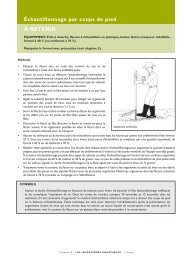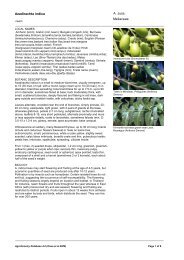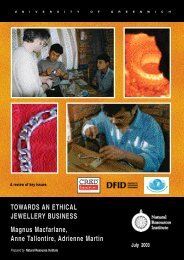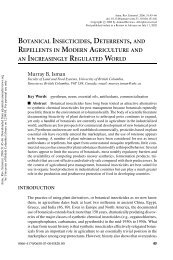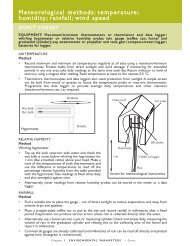African Water Laws - Natural Resources Institute
African Water Laws - Natural Resources Institute
African Water Laws - Natural Resources Institute
Create successful ePaper yourself
Turn your PDF publications into a flip-book with our unique Google optimized e-Paper software.
SHAH<br />
stress. However, in most states, they receive a constant 8-10 hours/day of poor quality power supply throughout<br />
the year. If SEBs were to invest in understanding farmers as customers, it should be possible for them to supply<br />
20 hours/day of good quality power to farmers on 30-40 days of peak irrigation need while maintaining 3-4<br />
hours/day supply on other days. In order for such an approach to work, the nature and capabilities of the power<br />
utilities have to change; so also does the thinking of donors and governments.<br />
High Transaction Costs, Potentially High Pay offs<br />
Rather than evolving organically from the unfolding situation on the ground—and therefore being demanded<br />
by stake holders-- many of the reforms currently being pursued in India, such as Irrigation Management<br />
Transfer, River Basin Management, metering of electricity, are actually promoted aggressively by researchers<br />
as well as funding agencies 13 , and are sometimes out of sync with the prevailing Indian context. By far the<br />
most frequent are situations where institutional interventions proposed would yield high productivity pay-offs if<br />
successful; but they rarely succeed because of high transaction costs. In Independent India’s history, the<br />
‘communitarian ideal’—the notion that villagers will instantly come together to take over the responsibility of<br />
participatory, democratic management of virtually anything (land, water, watersheds, forests, irrigation<br />
systems, river basins)—has been behind innumerable abortive institutional interventions. What has helped fuel<br />
this enthusiasm for participatory irrigation management by farmers are occasional examples of such models<br />
having worked reasonably well either in the industrialized countries or in India itself but under the tutelage of<br />
an inspired local leader or an industrious NGO. Its having worked in a few situations in exceptional conditions<br />
becomes the basis for designs of major programs of institutional interventions, commonly bank-rolled by an<br />
international donor. A classic example is Participatory Irrigation Management (or its cousin Irrigation<br />
Management Transfer) which has been, for the past four decades, the ruling mantra for improving the<br />
productivity of irrigation systems in India. What is extraordinary about this preoccupation with PIM (or IMT) is<br />
the sway it has continued to hold despite virtually no evidence of it having succeeded anywhere except on an<br />
experimental scale 14 . WUA’s have been tried out on small irrigation systems since 1960. Uttar Pradesh tried<br />
Sinchai Samiti’s (Irrigation Committees) way back in early 1960’s on irrigation tanks and reservoirs; following<br />
it, Madhya Pradesh too tried it on thousands of its minor irrigation tanks. Other states have been trying to make<br />
Pani Panchayats (<strong>Water</strong> Assemblies) work. But Sinchai Samiti’s of Madhya Pradesh and Uttar Pradesh have<br />
disappeared without trace; and so have Pani Panchayats in Gujarat and elsewhere. Yet, Orissa recently made a<br />
law that transferred all its minor irrigation systems to instantly-created Pani Panchayats. Gujarat introduced<br />
Joint Irrigation Management Program as far back as in 1983 but the 17 Irrigation Co-operatives lost money and<br />
became defunct. In 1991; it made another attempt, this time around with assistance from NGOs; and 144<br />
Irrigation Co-operatives cover 45,000 ha of irrigated area(Shukla, 2004); however, it is difficult to see precisely<br />
in what way these areas are better off than other commands. Indeed, a core idea of Command Area<br />
Development Agencies (CADAs) in early 1980’s was to involve farmer organizations in the management of<br />
irrigation projects; and we see no trace of CADA’s or their Beneficiary Farmers’ Associations (BFAs)<br />
including in Kerala where thousands of these were formed under a ‘big bang’ approach during 1986. An<br />
assessment by C J Joseph (2001) in late 1990’s suggested that, even in this land of strong traditions of local<br />
governance, high education and high levels of people’s participation, BFAs were damp squib 15 . A la Kerala,<br />
Andhra Pradesh overnight transferred the management of all its irrigation systems to over 10,000 WUAs<br />
created by fiat and a World Bank loan; this ‘big bang’ approach to PIM has attracted all-round interest;<br />
however, now that the World Bank funds retailed to WUAs for maintenance are over, field observers are<br />
beginning to wonder precisely what the WUAs are doing better (Jairath 2004) 16 .<br />
The central assumption underlying PIM/IMT is that once irrigation management is transferred from remote<br />
bureaucracies to WUAs, financial viability of the systems would improve and so would the quality and<br />
reliability of irrigation; physical and value productivity of water and land would increase, and irrigation<br />
systems would better achieve their potential for food and livelihood security for farmers in their command.<br />
PIM/IMT programs have belied many of these expectations even in countries like Turkey, Mexico and<br />
Philippines where they are known to have succeeded. As a result, early expectations from PIM/IMT have<br />
been increasingly moderated and IMT is now considered successful even if it just ‘saves the government<br />
money, improves cost effectiveness of operation and maintenance while improving, or at least not<br />
weakening, the productivity of irrigated agriculture’ (Vermillion 1996:153). The drift of the IMT discussion,<br />
in recent times, then has been more towards getting irrigation off the back of the governments than towards<br />
2-9



